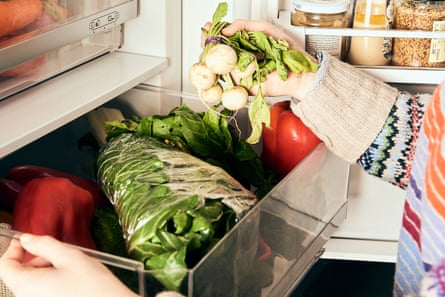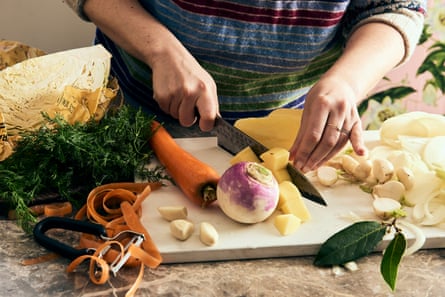
Your fridge’s crisper drawer is the first kitchen skill worth cracking. Even if you’ve grown to refer to yours as “the rotter” where that hopeful haul of herbage snapped up at the shops in a spontaneous “health kick” goes to die. Especially so!
Rather than letting your vegetables gloop and congeal, extend their lives. And if they start to look a little lank, there’s a tasty way to transform them into a midweek marvel.
The first thing to note is that fruit and vegetables are like families – some members get along better than others. Soft herbs, leaves and brassicas are tetchy. Leave them near ethylene-emitting produce (ie most fruits) and they’ll turn yellow and shrivel and curl in on themselves. As a rule of thumb, cold-weather veg get priority in the crisper, because the crisper is closest to their natural habitat.
Brassicas: wrap them up
Brassicas – such as kale, cauliflower, broccoli, cabbage and brussels sprouts – prefer to breathe, so anything airtight will do more harm than good. Wrap them in damp kitchen towel, then bag loosely.
Larger cruciferous vegetables such as cabbage and wombok have their own natural wrapping in the form of their outer leaves. If you’re not using it all at once, remember to rewrap in damp towel or the cut side will discolour and dry out.
If you’ve scored rootier brassica such as radishes, turnips and daikon with their tops still attached, it’s best to divide and conquer. Cut off the leafy tops as they have a propensity to suck the life out of the main bulb of the vegetable. The bulb goes in the crisper, but don’t throw out the tops – they’re delicious. Place in a bag, store on the fridge shelf and treat them like rocket. Just make sure you give them an extremely judicious wash, as they tend to be gritty.
Root vegetables: keep the tops

Hardier root vegetables such as carrots and beetroot do best in the crisper too. If you’re running low on space, bag and pop on the shelf above though. As for the tops, leafy carrot tops are akin to a peppery parsley, and beetroot tops are quite like silverbeet.
Nightshades: keep out
Nightshades such as tomatoes, capsicums and eggplants are warmer-weather veg and fare best away from the crisper. Potatoes are particularly fridge-phobic, as this exposes them to too much light, dries them out and changes their starch structure (a good thing only if you’re making gnocchi). Keep them in a cool, dry place away from direct sunlight – unless you live in a hot climate, in which case paper-bagging and refrigerating is the lesser of two evils.
Onions: keep them away from potatoes
While we’re on spuds, remember those feuding family members I mentioned? It’s a terrible idea to store onions and potatoes in the same place – they will tear each other down. If your potatoes are in the pantry, paper-bag your onions and place in the crisper; if your spuds are in the fridge, store onions in the pantry.
Herbs and leaves: keep them in a box

To store soft herbs and lettuce leaves, wash and spin-dry, then wrap in damp paper towel, pop in an airtight container or calico bag and place on the shelf above the crisper.
Fruits: keep them out of the cold
It’s best to store fruit (except perhaps berries) outside of the fridge entirely. Not only is it better for ripening, but fruit tastes better at room temperature and there’s less risk of fridge odours or dehydration ruining softer fruits. There may be circumstances when refrigeration is necessary, like if you live in the tropics or the fruit is on the turn. In this case, try storing fruit on the shelf above the crisper, or place in reusable bags to keep the “fruit farts” on lock.
A final tip
Ultimately, the best way to prevent your crisper from becoming a vegetable graveyard is to keep things moving. Whenever you bring home a haul from the shops or markets, remove your older produce from the crisper. Wipe the bottom with a little white vinegar, pop in the new vegetables first, then put older produce on top. This will encourage you to use up everything you’ve got, no matter how wilty – because it all comes out in the wash (or simmer!) in “crisper soup” recipes like shchi.
Shchi – recipe
Shchi (pronounced “she”) is essentially a cabbage soup whose etymology stems from the old Slavic siitii, the plural form of satiety or satisfaction. It’s quite literally the soup of mass satisfaction. Growing up, a big pot of this or borsch was Mum’s standing Sunday simmer – it was cost- and time-effective, and a bowl of either soup was her guarantee we’d be nourished.

Think of shchi as white borsch, where the beetroot has been subbed out for earthy sweet vegetables such as swede or turnip, and the acid amped up with apple cider vinegar. If you have some brine from dill pickles or kraut, feel free to use this instead of the vinegar. Kimchi brine would also be a welcome addition if you want a little heat.
I’ve kept this recipe fully plant-based but if you’d prefer more richness, foam in a knub of butter with the oil when sweating the veg, and use chicken stock. If you’re using a commercial stock, taste the soup before adding any extra seasoning as some stocks can be quite salty. And don’t forget to collect all of the vegetable trim and peels (except the cabbage) and pop into a bag in the freezer, ready to make more stock for your next shchi.
The flavour of the shchi gets better overnight and will happily last in the fridge for five to seven days – just in time for your next crisper clearout.

Makes 8-10 serves
¼ cup olive oil
1 brown onion, halved and finely sliced
1 small fennel, bulb halved and thinly sliced all the way up to the stalks, fronds reserved
1 large carrot, roughly chopped
3-4 cloves garlic, finely sliced
½ bunch dill, stalks and fronds chopped, finer fronds reserved for garnish
¼ cup apple cider vinegar
1 large turnip or swede (or 2-3 smaller ones), roughly chopped
2 waxy potatoes, such as nicola or desiree, roughly chopped into 2cm cubes (300g)
2 bay leaves, fresh or dried
500ml vegetable stock
1.5 litres water (preferably filtered)
¼ small white cabbage, finely sliced
Sour cream and extra-virgin olive oil, to serve
Heat a heavy-based Dutch oven or large pot on medium heat. Add the olive oil, onion, sliced fennel bulb and carrot, wait for it to sizzle, then lower the heat to medium-low and cover with the lid for 10 minutes, stirring occasionally. Once the fennel and carrot have softened and the onion is translucent, add the garlic and dill stalks, stir and cook until fragrant (about two minutes).
Deglaze the pan with the apple cider vinegar, then add the turnip (or swede, if using), potatoes and bay leaves. Pour in the stock and water, bring to the boil, then lower to a simmer and cook for about 25 to 30 minutes until the potatoes are fork-tender.
Add the cabbage and most of the dill and fennel fronds (keeping some of the finer fronds for garnish). Stir to combine, then turn off the heat, cover and let the cabbage cook in the residual heat for 10 to 15 minutes. Season with salt and pepper to taste.
To serve, ladle into soup bowls and add a dollop of sour cream, garnishing with reserved dill and fennel fronds. Finish with a drizzle of olive oil and a sprinkle of salt and freshly cracked pepper.


